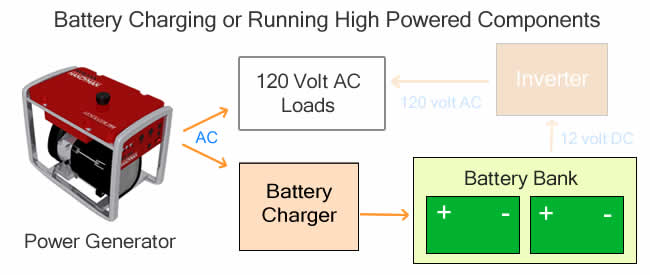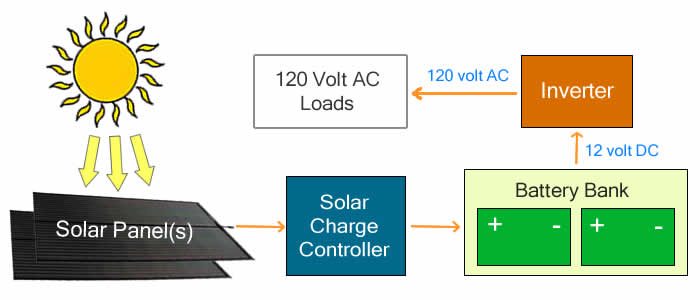An appropriately sized solar array should be able to recharge your RV battery bank each day with adequate exposure to the sun. In an RV our location and conditions are always changing though. Your solar panels may not be able produce enough energy to keep up with power consumption in shaded locations, on short winter days or during bad weather. Having second way to charge your house batteries will help in these situations.
If you’re able to power your RV for two or three days on batteries alone, then perhaps a generator is not needed. It really depends on your needs and ability to scale back your power usage.
So, how many days can you power your RV off-grid from batteries alone and no solar charging? Here are some tips to help figure that out.
How Much Electricity Do You Need?
Since everybody’s needs will vary, you should understand what your specific needs are before choosing whether to go the solar route or stick with a power generator.
High draw equipment like residential refrigerators and air conditioners will draw the most energy from your system. Powering high draw equipment with an off-grid solar system and battery bank will require a very powerful and expensive system. For this reason, most opt for a portable or on-board generator.
Lights and personal electronics radios, computers and TVs are considered low draw components. A generator or moderately sized battery bank, inverter and solar system can handle this type of use without any trouble.
In this article I break down the costs of various off-grid RV solar system configurations. It should give you an idea of what you’ll have to spend.
Assuming you’ve already decided that remote camping is what you want to do, ask yourself these questions and get a better understanding of your electricity needs:
- In a 24 hour period what will you be doing?
- What electrical equipment will you need?
- What type of electricity does each component use (AC or DC)?
- Calculate how much power each of those electrical components use (electrical current measured in Amps)
AC powered appliances like your laptop power supply, television, or stereo have the Amp draw written on the back of the unit somewhere. Plugging your equipment into an inexpensive Kilowatt meter will quickly show you how much power is being used.
Shop for Kilowatt meters on Amazon
DC powered consumption can be more difficult to measure since those components are typically wired directly into the RV. Using a DC clamp meter on your battery cable will work.
You can also install a battery monitoring system to measure energy consumption. I recommend you install a battery monitoring system early on. You’ll need one eventually. Here is an article reviewing the most popular battery monitoring systems for RVs.
To estimate your daily electrical consumption simply add everything up. Create a list of electrical components like I’ve done below indicating each item’s current draw (in Amps), and how many hours you’ll need it in a given day.
| Component | Current (Amps) | Hours | Amp Hours (amps * hours) |
| Lights | 1 (5 low powered LED lights) | 6 | 6 |
| Laptop | 5 | 4 | 20 |
| TV | 7 (LED TV) | 3 | 21 |
| Fan | 3 | 5 | 15 |
| Gauges, detectors, etc. | 0.5 | 24 | 12 |
Note: 1 amp at 120 volts AC is roughly 10 amps at 12 volts DC. Multiply your AC amps by 10 to get the equivalent current rating at 12 volts DC.
Notice I didn’t include air conditioners, electric heaters or electric water heaters in this list.
Gas Powered Generators
Using a power generator is a suitable option for generating power. Many RVs come with onboard generators or can be easily connected to an external one. The drawback to running an onboard or external generator is that it requires a steady supply of fuel. They can also be noisy. For those reasons, RVers who use generators usually use them on an “as needed” basis to recharge their battery bank at the end of the day.
Small portable generators are popular options for battery recharging since they use less fuel and are generally quieter. A popular option is to plug a multi-stage battery charger to a small gas powered generator.

Generators are also great backup power sources when your primary power source is solar. They provide enough power to run heaters, air conditioners and microwave ovens as needed.
Charging with Solar Panels
If you plan to do a lot of remote camping, then a solar charging system is something you should consider. Powered by the sun, a solar charging system can recharge your batteries indefinitely. Whenever the sun is shining you’re solar panels will be generating power. Unfortunately, solar requires an investment on your part as most RVs do not come with solar panels installed.
A typical RV solar charging system consists of solar panels plus a solar charge controller (your battery charger for solar). To power household items (via standard 120 volt AC receptacles) you will also need a power inverter. Inverters convert DC battery power to household AC power and come in a variety of sizes measured in watts (e.g. 500, 1000, or 2000 watts).

More RV Solar Information
If you’re considering a permanent solar installation, I recommend taking some time to understand your options. Start by reading our Free Solar Panel Guide which also covers basic solar concepts and answers common questions.
